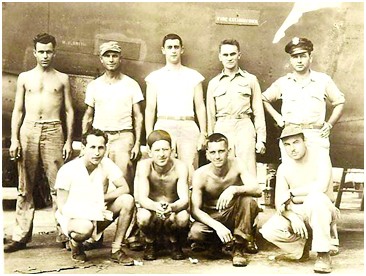Group photo of Ray and his crew with the ill-fated plane in the background. Photo Courtesy Kevin Hooper.

Susan Kurzawski Rader
As we mark the 80th anniversary of the tragic air crash that claimed the life of my uncle, Second Lieutenant Raymond Kurzawski, I am filled with deep gratitude and pride. It is an honor to share a bit about Uncle Ray, a man I never met but whose legacy has shaped my family’s history and inspired our enduring respect for those who served.
Raymond Kurzawski, known as Uncle Ray to our family, was the eldest son of Ray and Agnes Kurzawski. He was raised in Nanticoke, a small town in the coal regions of Pennsylvania, alongside his younger brother, my father, and their sister, Dorothy. The sons of a coal miner, both Ray and my father were filled with a yearning for adventure and a deep sense of patriotism, which led them to enlist in the military during World War II. My father joined the Army, while Uncle Ray chose the Air Corps, eager to take to the skies in defense of his country.
Uncle Ray’s journey was one of pride and excitement. Graduating as a second lieutenant and navigator, he stood tall among his peers, ready to serve with honor. His family, including his parents and younger sister, were immensely proud of his achievements.
Before he donned his uniform, Uncle Ray was a hair stylist, working alongside his mother in their family-owned shop. He was very handsome and, as family lore goes, quite the “ladies’ man.” It’s easy to imagine the charm and charisma he brought to his work and his life. I often wonder what life would have been like for him had he survived—what stories he would have told, what paths he might have taken, and how different our family’s history might have been.

Photo Courtesy Susan Rader.
Tragically, like so many brave men of his generation, Uncle Ray never returned home. His plane, flying a dangerous supply route from Jorhat to Kunming popularly known as ‘The Hump’, went down, and all aboard were lost. Six years later, I was born into a world forever changed by the loss of so many young lives, including my uncle’s.
As a child, my sisters and I would spend hours poring over Uncle Ray’s scrapbooks and photo albums, imagining the exciting life he led before his final mission. Though we never knew him, we felt a profound connection to the man who had given so much for his country.
Today, our family is deeply moved by the memorial that has been constructed in honor of Uncle Ray and his crew, by the people of Molungkimong in Nagaland, India, ensuring that their sacrifice is not forgotten. The dedication and effort of everyone involved in the memorial and annual remembrance ceremonies mean more to us than words can express.
It is hard to believe that 80 years have passed since that fateful day. The pain of loss lingers, but so does the pride we feel in being part of Uncle Ray’s legacy. His story is one of countless others from a time when ordinary men and women did extraordinary things for the sake of freedom.
As we commemorate this solemn anniversary, we remember not only the lives lost but also the lives forever changed. We are grateful for the enduring efforts to honor these heroes, ensuring that their sacrifices are remembered for generations to come.
In memory of Second Lieutenant Raymond Kurzawski and his fellow servicemen, we say thank you—for your bravery, your service, and your ultimate sacrifice.
Second Lieutenant Raymond Kurzawski served as the navigator of a USAAF F-7A Photo Reconnaissance Liberator that crashed in the village of Molungkimong, Mokokchung, Nagaland, on August 11, 1944, during World War II, resulting in the death of all 12 crew members.
Seventy-six years later, following extensive research into the incident, the people of Molungkimong honored the fallen by erecting a memorial at the crash site in 2020. Each year on the anniversary of the crash, the village holds a prayer service in remembrance of the crew. Additionally, a museum has been established in Molungkimong, preserving the remains of the plane and commemorating the memories of the lost servicemen.



